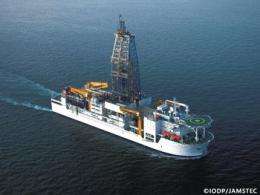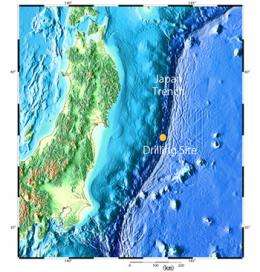International drilling expedition to probe Japanese fault zone

(PhysOrg.com) -- The scientific drilling ship Chikyu will set sail on April 1 on an ambitious expedition to drill into the fault that caused the devastating Tohoku earthquake and tsunami in March 2011. Emily Brodsky, a professor of Earth and planetary sciences at the University of California, Santa Cruz, has been planning for this project since 2008, when she helped organize an international workshop on "rapid response drilling."
Drilling a borehole into a fault soon after a large earthquake could answer questions that have bedeviled seismologists for years. "If you want to know the forces acting on a fault during an earthquake, it turns out to be an incredibly hard problem," Brodsky said. "Pretty much the only way to do it is to get physically onto the fault after an earthquake."
The friction as two massive plates of the Earth's crust slide past one another is dissipated as heat, so temperature measurements can give scientists a handle on the fault's resistance to sliding during the earthquake. Rock samples recovered from drilling can also give clues to what happens on the fault during and after a large-slip event. Although an undersea fault is not an ideal target for rapid response drilling, the Tohoku event presented a unique opportunity due to the huge amount of slippage on the fault--a record-breaking 50 meters.
Within a week after the earthquake struck, Brodsky and Japanese seismologist James Mori were working to pull together a committee of scientists and prepare a proposal to the Integrated Ocean Drilling Program (IODP). IODP agreed to fund the project, known as the Japan Trench Fast Drilling Project (JFAST), or IODP Expedition 343. Mori is co-chief scientist on the expedition. Brodsky serves on the project management team and will take a lead role in the data analysis.
Two UC Santa Cruz scientists will be on board the Chikyu during the two-month expedition. Casey Moore, research professor of Earth and planetary sciences, will be analyzing data from the borehole to determine when the drill has reached the fault. James Kirkpatrick, a postdoctoral researcher working with Brodsky, will be studying the drill cores, three-inch-wide cylinders of rock pulled out of the borehole during drilling.
"One of our goals is to be able to pick up a piece of rock that has slipped 50 meters and see what it looks like," Brodsky said. "That's the largest slip ever measured, and what it looks like is important for several reasons. First, we want to be able to recognize it if we see it somewhere else, which would tell us we had a fault capable of a similar event. Second, it can help us identify the processes that control friction on the fault. And it can also tell us about the re-strengthening process--how the fault heals after an earthquake."

Kirkpatrick said much of his past research has been done on ancient faults that have taken 50 million years to come to the surface where geologists can study them. "Here I will get to study fresh samples," he said.
The engineering challenges for the drilling operation are daunting, however, and success is not guaranteed. The seafloor where scientists plan to drill is seven kilometers (four miles) deep, and the Chikyu will have to drill another kilometer below the seafloor to reach the fault. "This is high risk, high reward science. It's an ambitious program, and from a scientific perspective it's very exciting," Moore said.
Kirkpatrick said he has been amazed by the technology that will be used on the Chikyu. "The more I learn about the engineering part of this project, the more I'm taken aback by what it's possible to do. It's like a space mission," he said.
The main operations to be completed during the expedition consist of drilling two boreholes at a site located off the Oshika Peninsula, just west of the Japan Trench. The first hole is dedicated to collecting geophysical data and locating the fault zone, and the second hole is dedicated to retrieving core samples from across the Tohoku earthquake slip surface. Temperature and pressure sensors will be deployed in each hole, and data will be sent up to a data logger at the wellhead. The data will be retrieved after six months by a remotely operated vehicle.
The Chikyu is a state-of-the-art scientific drilling vessel operated by the Japan Agency for Marine-Earth Science and Technology (JAMSTEC). More information about the JFAST expedition is available at www.jamstec.go.jp/chikyu/exp343/e/ .
Provided by University of California - Santa Cruz
















